抽象主义与超写实主义共20页
- 格式:ppt
- 大小:2.57 MB
- 文档页数:20
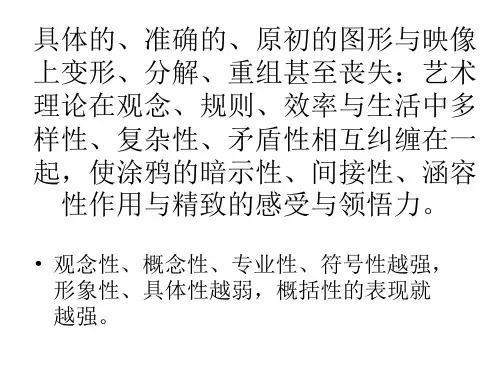



超级写实主义超级写实主义(Hyperrealism,又称高度写实主义),是绘画和雕塑的一个流派,其风格类似高分辨率的照片。
超级写实主义可以看作是照相写实主义(Photorealism)的发展。
自2000年代早期以来,该术语在美国和欧洲作为一个独立的艺术运动和艺术风格发展起来。
[1]历史莫罗·大卫(Mauro David)创作的一幅超级写实主义作品《水晶盘上的甜瓜》法语术语“Hyperréalisme”由Isy Brachot创建于1973年。
它是当年在他位于比利时布鲁塞尔的画廊的一个主要的展览的标题。
该展览主要是由美国照相写实主义画家组成,包括拉尔夫·戈因斯(Ralph Goings)、查克·克洛斯(Chuck些细节。
[7][8]他们经常省略人物的表情、政治价值和叙述元素。
照相写实主义风格演变自波普艺术,作品通常紧凑精致,线条分明,突出重点。
[9]超级写实主义则与之相反,虽然本质上参考照片,常常对描绘的主题处理得更柔软更复杂,使之表现成一个生动的对象。
超级写实主义作品中的对象和场景描绘得非常精致,创造出原始照片中没有的一个新的现实的幻想。
这并不是说他们是超现实主义,因为这种幻想是一个令人信服的描写现实。
纹理、表面、灯光效果和阴影画表现得清晰,比参考照片甚至实物还要鲜明。
[10]超级写实主义的哲学根源自让·鲍德里亚的理论,“模拟的东西永远不在现实中存在”。
( the simulation of something which never really existed.)[11]因此,超级写实主义创建了一个虚假的现实,是一个令人信服的幻想,是基于现实的一个模拟。
超级写实主义绘画和雕塑作品是数码相机拍出并在计算机上显示的超级高分辨率的照片的副产品。
就如照相写实主义效仿模拟摄影,超级写实主义利用数码照片并扩展之来创造一个新的现实的感觉。
[12][2]超级写实主义绘画和雕塑使观众得到高清晰度图像的幻觉,但是比图像更细致。
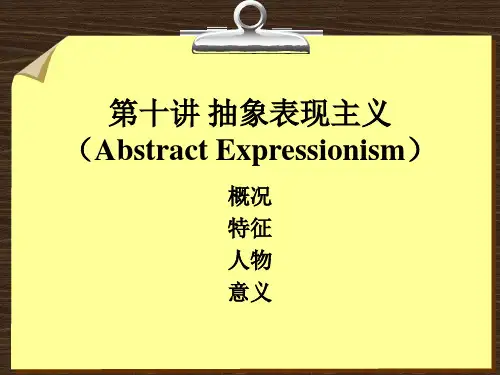

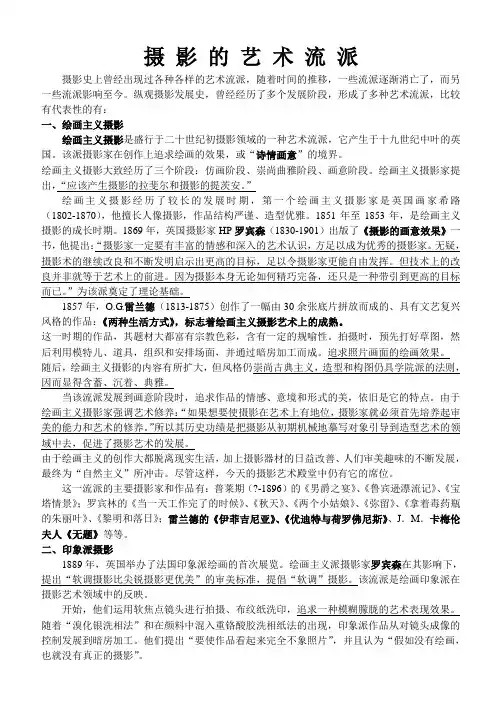
摄影的艺术流派摄影史上曾经出现过各种各样的艺术流派,随着时间的推移,一些流派逐渐消亡了,而另一些流派影响至今。
纵观摄影发展史,曾经经历了多个发展阶段,形成了多种艺术流派,比较有代表性的有:一、绘画主义摄影绘画主义摄影是盛行于二十世纪初摄影领域的一种艺术流派,它产生于十九世纪中叶的英国。
该派摄影家在创作上追求绘画的效果,或“诗情画意”的境界。
绘画主义摄影大致经历了三个阶段:仿画阶段、崇尚曲雅阶段、画意阶段。
绘画主义摄影家提出,“应该产生摄影的拉斐尔和摄影的提茨安。
”绘画主义摄影经历了较长的发展时期,第一个绘画主义摄影家是英国画家希路(1802-1870),他擅长人像摄影,作品结构严谨、造型优雅。
1851年至1853年,是绘画主义摄影的成长时期。
1869年,英国摄影家HP罗宾森(1830-1901)出版了《摄影的画意效果》一书,他提出:“摄影家一定要有丰富的情感和深入的艺术认识,方足以成为优秀的摄影家。
无疑,摄影术的继续改良和不断发明启示出更高的目标,足以令摄影家更能自由发挥。
但技术上的改良并非就等于艺术上的前进。
因为摄影本身无论如何精巧完备,还只是一种带引到更高的目标而已。
”为该派奠定了理论基础。
1857年,O.G.雷兰德(1813-1875)创作了一幅由30余张底片拼放而成的、具有文艺复兴风格的作品:《两种生活方式》,标志着绘画主义摄影艺术上的成熟。
这一时期的作品,其题材大都富有宗教色彩,含有一定的规喻性。
拍摄时,预先打好草图,然后利用模特儿、道具,组织和安排场面,并通过暗房加工而成。
追求照片画面的绘画效果。
随后,绘画主义摄影的内容有所扩大,但风格仍崇尚古典主义,造型和构图仍具学院派的法则,因而显得含蓄、沉着、典雅。
当该流派发展到画意阶段时,追求作品的情感、意境和形式的美,依旧是它的特点。
由于绘画主义摄影家强调艺术修养:“如果想要使摄影在艺术上有地位,摄影家就必须首先培养起审美的能力和艺术的修养。

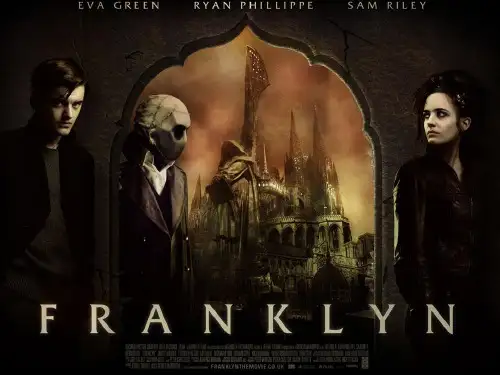
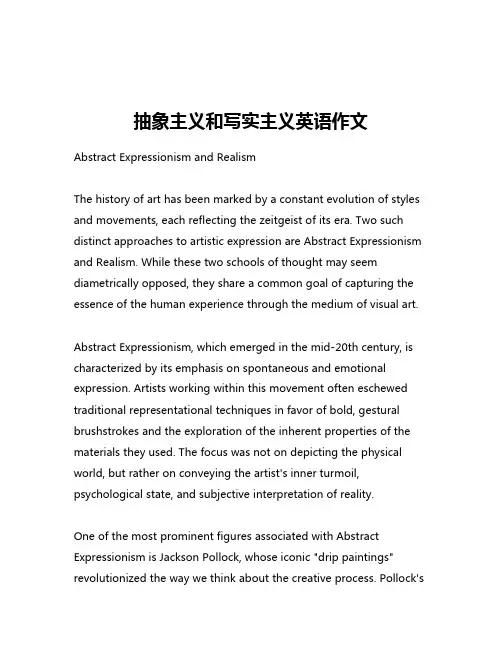
抽象主义和写实主义英语作文Abstract Expressionism and RealismThe history of art has been marked by a constant evolution of styles and movements, each reflecting the zeitgeist of its era. Two such distinct approaches to artistic expression are Abstract Expressionism and Realism. While these two schools of thought may seem diametrically opposed, they share a common goal of capturing the essence of the human experience through the medium of visual art.Abstract Expressionism, which emerged in the mid-20th century, is characterized by its emphasis on spontaneous and emotional expression. Artists working within this movement often eschewed traditional representational techniques in favor of bold, gestural brushstrokes and the exploration of the inherent properties of the materials they used. The focus was not on depicting the physical world, but rather on conveying the artist's inner turmoil, psychological state, and subjective interpretation of reality.One of the most prominent figures associated with Abstract Expressionism is Jackson Pollock, whose iconic "drip paintings" revolutionized the way we think about the creative process. Pollock'swork was a radical departure from the traditional easel painting, as he would pour, drip, and fling paint onto the canvas, often working on a large scale. The resulting compositions were a dynamic interplay of color, texture, and movement, reflecting the artist's own visceral and instinctive approach to the act of painting.Another key figure in the Abstract Expressionist movement was Willem de Kooning, whose paintings were characterized by their fragmented, disjointed forms and vibrant, expressive brushwork. De Kooning's work often explored the tension between figuration and abstraction, with the human form serving as a starting point for his exploration of the expressive potential of paint.In contrast, Realism is a style of art that seeks to accurately depict the physical world and the human experience in a naturalistic manner. Realist artists strive to capture the details of their subjects with meticulous attention to accuracy, often using photographic references and a highly refined technical approach.One of the most renowned Realist painters is the American artist Andrew Wyeth, whose work is renowned for its quiet, contemplative depictions of the rural landscapes and people of his native Pennsylvania. Wyeth's paintings are marked by a sense of stillness and introspection, with the artist's keen eye for detail and subtle use of light and shadow creating a sense of emotional resonance andpsychological depth.Another influential Realist artist is the Spanish painter Joaquín Sorolla, whose vibrant, sun-drenched scenes of coastal life in Spain have become iconic. Sorolla's paintings are characterized by their vivid colors, dynamic compositions, and masterful rendering of the effects of light on the human form and the natural world.While Abstract Expressionism and Realism may seem like polar opposites, they share a common thread in their desire to capture the essence of the human experience through the visual arts. Abstract Expressionist artists sought to convey the raw, unfiltered emotions and psychological states of the individual, while Realist artists strived to faithfully represent the physical world and the human condition in all its complexity.Ultimately, both movements have had a profound impact on the trajectory of art history, and their influence can be seen in the work of countless contemporary artists who continue to grapple with the fundamental questions of what it means to be human and how we can best express the depth and complexity of our lived experiences through the medium of visual art.。
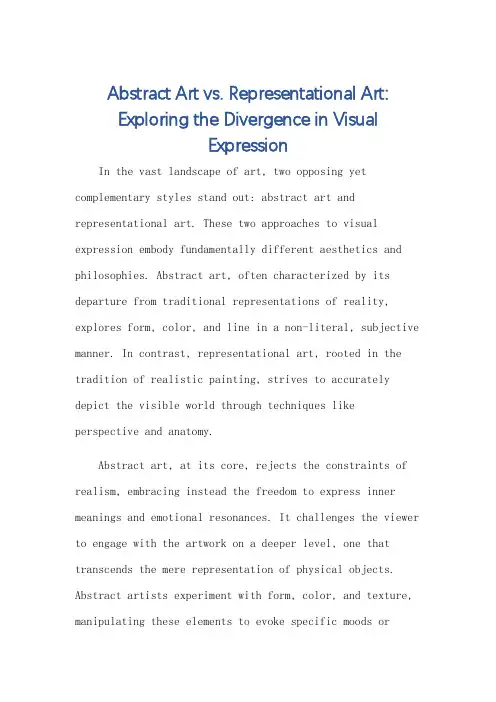
Abstract Art vs. Representational Art:Exploring the Divergence in VisualExpressionIn the vast landscape of art, two opposing yet complementary styles stand out: abstract art and representational art. These two approaches to visual expression embody fundamentally different aesthetics and philosophies. Abstract art, often characterized by its departure from traditional representations of reality, explores form, color, and line in a non-literal, subjective manner. In contrast, representational art, rooted in the tradition of realistic painting, strives to accurately depict the visible world through techniques like perspective and anatomy.Abstract art, at its core, rejects the constraints of realism, embracing instead the freedom to express inner meanings and emotional resonances. It challenges the viewer to engage with the artwork on a deeper level, one that transcends the mere representation of physical objects. Abstract artists experiment with form, color, and texture, manipulating these elements to evoke specific moods orideas. The result is often a dynamic and engaging visual experience that encourages active interpretation.On the other hand, representational art adheres to a more literal and objective approach. Artists in this tradition strive for accuracy and realism, seeking to replicate the world as it appears to the naked eye. This style relies heavily on techniques like perspective, lighting, and anatomy to create a convincing illusion of three-dimensional space. The focus is on capturing the essence of a subject matter, whether it's a landscape, a portrait, or a still life, in a way that is both visually appealing and factually accurate.Despite their apparent differences, abstract art and representational art are not mutually exclusive. In fact, many artists throughout history have successfully integrated both approaches into their work. Abstract elements can be found even in the most realistic paintings, adding depth and emotional resonance. Similarly, representational art can benefit from abstract techniques, as they provide a means to express ideas and emotions beyond mere representation.The divergence between abstract art and representational art, therefore, lies not just in their aesthetics but also in their philosophical underpinnings. Abstract art champions the individuality and subjectivity of visual expression, while representational art values objectivity and accuracy. Both styles, however, are integral to the rich tapestry of art history and continue to influence and inspire artists of all stripes.**抽象主义与写实主义:视觉表达的分歧探索**在艺术的广阔领域中,两种相对立但又互补的风格脱颖而出:抽象艺术和写实艺术。
写实派、印象派、简约派、抽象派都分别怎么解释写实派:写实绘画从表面看,是一个古典和传统的样式。
从最早的西班牙岩画到十九世纪的法国学院派、印象派;从前苏联的绘画到中国社会主义时期的讲究题材的油画,都是写实的面貌。
但是,一个绘画样式能够逾千年不衰,并不是仅靠传承或某一教学体系所决定的。
现代科学研究证明,艺术是人的物质形态外化延伸的结果。
在人的大脑里面,一些区域对形、色彩、比例、平衡进行专门的感应、解析,这就是为什么人们在生活中对物质形态的判断标准基本相同。
从写实绘画来看也是一样。
比勃鲁盖尔、伦勃朗早数百年,在荒漠的欧洲大地并不知晓的东方,已经有马远、范宽、周昉、张暄这样的写实画家了。
尽管近代的东西方有了彼此间相互影响的诸多机会,也的确存在因为文化上的交流,产生过像后期印象派画家高更、凡高作品中的浮士绘痕迹;存在于中国油画家作品中追求塑造和色彩的欧洲绘画体系的结晶。
但是,写实绘画在中国真正得以传承和发扬光大的原因,却来源于一个更大的渊源,那就是超越存在于我们作为人的基因特性,和艺术家对与生俱来的人性基因的认同。
人性的超越存在是唯一可以解说出中国写实画家的兴趣和志向。
绘画在这个时候,已经不是简单的画画或者仅仅是技巧上的高标准追求,而是把生命的欢乐与痛苦都赌注在里面了。
在中国艺术历史上存在过不少志同道合者组成的艺术团体,但像中国写实画派这样一个由一群在当代中国有着巨大影响力的画家所组成的团体实数罕见。
画派中如陈逸飞、艾轩、杨飞云、王沂东、何多苓等,自上个世纪八十年代以来一直作为公认度极高的中国油画的领军人物,他们的作品始终是美术界和公众的关注点。
中国写实画派的画家都是改革开放后成长起来的,其中大部分人成名于上个世纪八十年代。
一个开放的环境不仅使他们感受到西方现代艺术的冲击,也使他们见到了作为现代艺术靶子的西方传统绘画。
他们遵从内心的选择,不屑于被当代艺术排斥,努力完成心中的目标。
终于在2004年5月,他们团聚在一起,决定以年展的方式,向大众展示他们注满心血和情感的作品。